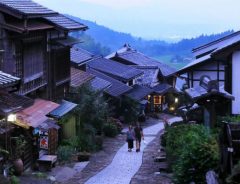
Children in the Shugendo Festival, Dorogawa, Tenkawa Village, Nara Prefecture., courtesy of JAPAN Forward
Tenkawa Village in Nara: The Sacred Location of ‘Shugendo’
- Tags:
- JAPAN Forward / Nara / Nature / Shugendo
Related Article
-

Footage Shows Abandoned Areas Of Fukushima Being Reclaimed By Nature 7 Years Later
-

Mass summer gathering phenomenon of Nara’s famous deer has netizens perplexed
-

Treasures along the Arakawa Line: Retro Amusement reopens
-

Edo Era Post Towns Charm Foreign Hikers from Magome to Tsumago
-

Arrival of baby deer in Nara Park announces the start of the fawning season
-

Japanese Nature Artist Creates Adorable and Delicate White Bunnies Out of Only Natural Materials


A steep mountain with deep ravines surrounded by green trees gives birth to a river of life and a faith of gratitude that has resisted the test of time.
By Mizue Torikoshi / Japan FORWARD
Tenkawa Village in Nara Prefecture is the home of the Omine Mountain range. Called the roof of the Kinki west central Honshu region, it is the source of clear stream water, cold weather and little arable land. But the village is also host to occasions that bring people together.
Mt Sanjo (or as it’s most commonly known, Mt. Omine) sits at the foundation of ancient mountain worship, Shugendo, in Japan. The syncretic religion combines elements of Shinto and Buddhism with Taoism, primitive animist beliefs, and shamanistic practices, which are played out on some of Japan’s most sacred mountains.
Tenkawa Village prides itself on a long history of mountain monks and the people who have supported their training. It is also a Unesco World Heritage Site.
On the day of the festival, guests sit on the porch of an inn to watch the Yamabushi Shugendo parading through the hotspring village on August 3, Tenkawa, Nara Prefecture.
At the end of the festival, a stick on which prayers are written, called the Orei Goma, is ritually burned by Shugendo practitioners
Celebrating the Mystic En no Gyoja
On August 3, the author visited the village of Dorogawa hotspring at the entrance to the Omine mountain range. Although it was midsummer, the high altitude delivered cool air in the shade. Walking along the road at dusk, the sound of someone blowing conch shells could be heard.
The Gyoja Pilgrim Festival honors En no Gyoja, also known as En no Ozuno, an ascetic mystic who is believed to have opened the path to Mt Omine in the Asuka period, around the 7th century. For the first time in three years, spectators in 2022 could watch the “Oni Odori” (Ogre dance Parade), which recreates how the mystic was welcomed back to Omine from his exile in Izu.
Softly lit lanterns highlighted the Yamabushi parade as it passed through the hotspring town. The sound of blowing conch shells – also called trumpet shells – was followed by lively music.
Inns along the street opened their wide porches to hotel guests and villagers who fanned themselves. Time went by slowly.
Written by Japan ForwardThe continuation of this article can be read on the "Japan Forward" site.
[Hidden Wonders of Japan] Tenkawa Village in Nara: The Sacred Location of ‘Shugendo’